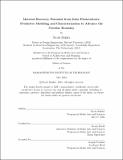| dc.description.abstract | In the next two decades, an exponentially growing quantity of waste will be generated as solar panels reach their end-of-life. Meanwhile, demand for new solar capacity will increase the value of key raw materials, underscoring the importance of recycling and movement toward a “circular economy”. However, uncertainties over the quantity and the exact material composition of solar panel waste hamper investments by recyclers, manufacturers, and governments. In this study, I construct a Material Flow Analysis model to forecast the global quantity of recoverable materials through 2100, informed by an experimental characterization of representative solar panels from the 1930s to 2020s. To account for potential changes in future demand, I develop two distinct scenarios: one explores the growing electricity demand from artificial intelligence use (‘Artificial Intelligence Boom’), while the other features renewable hydrogen production for steelmaking, shipping and the chemical industry (‘Green Hydrogen Takes Off’). The combined model predicts a lower material demand for silicon than previously anticipated in the base case, with a cumulative installed solar PV capacity of 50 TW and a waste volume of 3,600 metric megatonnes by 2100. This will require 45 megatonnes of solar-grade silicon by 2100, while 18 megatonnes could theoretically be obtained from recovered material. Achieving a circular economy for silicon is possible by the mid-2040s, but will require recovery rates above 70% and continued improvements in material efficiency as observed in the retrospective analysis. Recovery would suffice for all silicon demand through the mid-2060s, but not through 2100, because the demand for new solar panels and replacements outpace secondary supply. Of specific concern for material recovery is the material composition: results from characterization indicate the presence of toxic materials, including lead, and scarce elements in solar cells. | |
